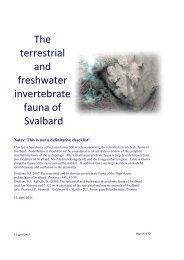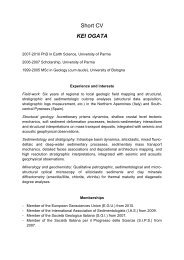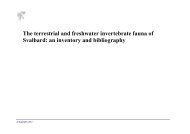Arctic plant ecology: From tundra to polar desert in Svalbard - Unis
Arctic plant ecology: From tundra to polar desert in Svalbard - Unis
Arctic plant ecology: From tundra to polar desert in Svalbard - Unis
You also want an ePaper? Increase the reach of your titles
YUMPU automatically turns print PDFs into web optimized ePapers that Google loves.
along a scale where 1 = dry, 2 = mesic, and 3 = wet. For soil pH, soil samples were<br />
taken <strong>in</strong> the field and analyzed <strong>in</strong>doors with a pH meter. Cover was estimated <strong>in</strong> the<br />
field as percentage of the frame, for vascular <strong>plant</strong>s, lichens, bryophytes, cryp<strong>to</strong>gam<br />
crust, and bare ground. In addition, mean canopy height of vascular <strong>plant</strong>s was<br />
estimated (<strong>in</strong> centimetres) <strong>in</strong> the frame. As a substitute for biomass, vascular<br />
biovolume was calculated for each site and frame as the canopy height (cm) multiplied<br />
by vascular <strong>plant</strong> cover (%). It has been shown <strong>in</strong> a study by L<strong>in</strong>dblad (2007), that<br />
vascular <strong>plant</strong> height was a better measure than biomass <strong>to</strong> expla<strong>in</strong> vascular <strong>plant</strong><br />
diversity <strong>in</strong> a midalp<strong>in</strong>e, Sub<strong>Arctic</strong> <strong>plant</strong> community. Similarly, Gough et al. (2000),<br />
found a unimodalshaped correlation of canopy height and species richness and<br />
density. This suggests that us<strong>in</strong>g biovolume is a measure at least as good as biomass.<br />
Lady Frankl<strong>in</strong>fjorden<br />
Biscayarhuken<br />
Florabukta<br />
Re<strong>in</strong>sdyrflya<br />
Mayerbreen<br />
Fjortende julibreen<br />
Ossian Sarsfjellet<br />
Colesdalen<br />
Kapp Thordsen<br />
Figure 1. Sites <strong>in</strong>cluded <strong>in</strong> this study.<br />
At each site, at least three replicate frame analyses were made (Table 1). For some of<br />
the measures (cover and soil moisture), subjective estimations were used. This was<br />
carried out by a large group of people tak<strong>in</strong>g turns and the preced<strong>in</strong>g calibration of<br />
methods may have been <strong>in</strong>sufficient <strong>to</strong> make sure that everybody carried out<br />
measurements <strong>in</strong> the exact same way. This should be kept <strong>in</strong> m<strong>in</strong>d when <strong>in</strong>terpret<strong>in</strong>g<br />
the data.<br />
13








